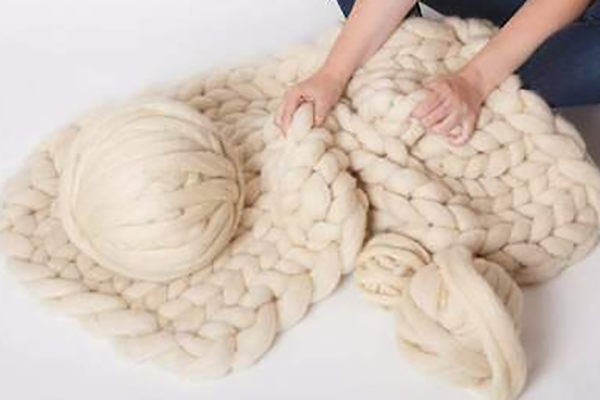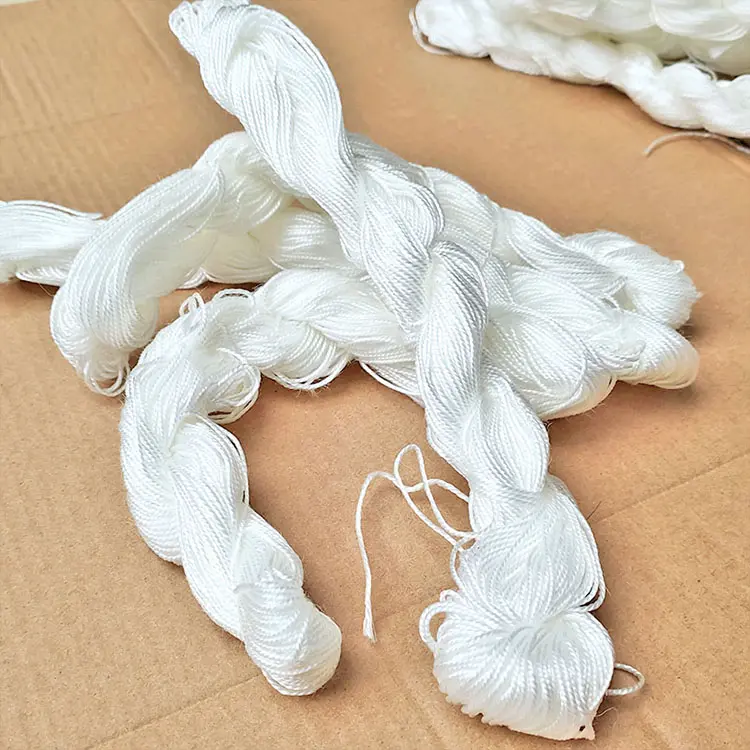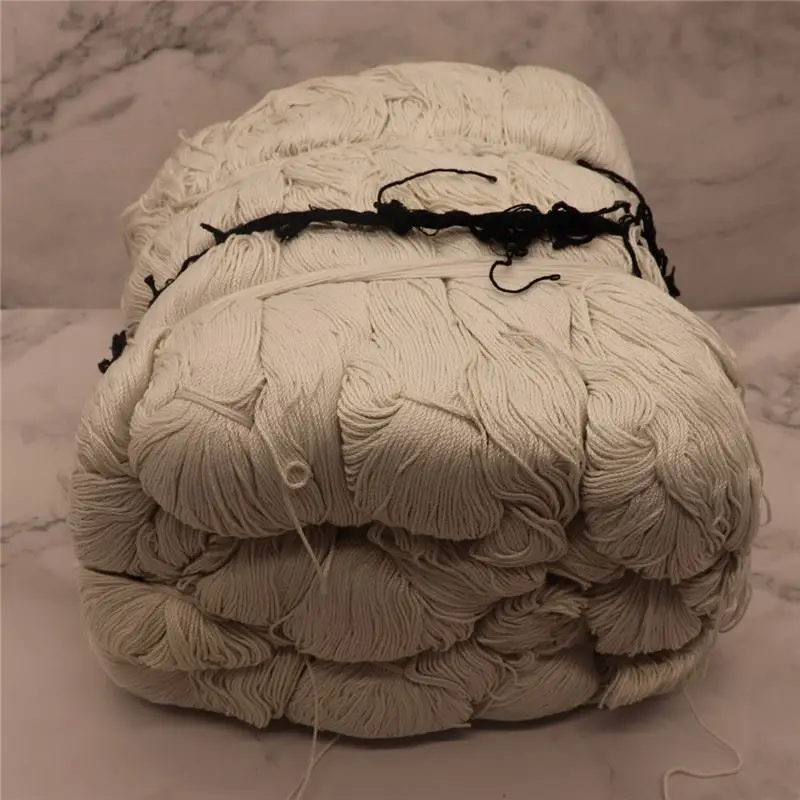Have you ever seen those incredibly thick, plush blankets that look like they were made for giants? That’s the magic of jumbo yarn. As the thickest and most substantial of all yarn weights, jumbo yarn allows you to create stunning, oversized projects in a fraction of the time it would take with conventional yarn. My name is Allen, and as a manufacturer and supplier in the textile industry for many years, I’ve seen trends come and go, but the appeal of jumbo yarn is undeniable. This article is your all-in-one guide to demystifying this wonderful material. We will explore everything from understanding the yarn weight system to choosing the perfect fiber and tools. Whether you’re a procurement officer like Mark Thompson looking for reliable bulk materials or a beginner crafter eager to start a new project, this guide will provide the expert insights you need to succeed.
What Exactly is Jumbo Weight Yarn and Why is it So Popular?
Jumbo weight yarn, often categorized as a #7 yarn on the Craft Yarn Council’s scale, is the heaviest and thickest yarn commercially available. Think of it as the big brother to super bulky yarn. Its sheer size is its most defining characteristic, making it instantly recognizable. This yarn is so substantial that some projects don’t even require tools like a needle or hook; you can simply use your arms to knit or crochet! This technique, known as arm knitting, is a major reason for its surge in popularity, especially among those looking for quick projects. A jumbo yarn creates a fabric with a dramatic, oversized stitch definition that is both modern and incredibly cozy.
The popularity of this yarn is driven by two key factors: speed and aesthetics. For business owners and manufacturers, time is money. Using a jumbo yarn means production cycles for items like chunky blankets or rugs can be significantly shorter. For the individual crafter, the satisfaction of completing a project in a single afternoon is immense. Aesthetically, the chunky, textured look of a jumbo yarn project fits perfectly with contemporary home decor trends. The oversized stitches make a bold statement, turning a simple blanket or pillow into a centerpiece. This kind of yarn is simply fun to work with, offering a unique tactile experience that is different from any other yarn weight.

How Do You Read a Yarn Label for Jumbo Yarn?
Understanding the information on a yarn label is crucial, especially when you’re dealing with a specialty material like jumbo yarn. The label is your primary instruction sheet, providing all the data you need to ensure your project is a success. As a supplier, we ensure our labels are clear because we know our customers, from large-scale garment manufacturers to individual crafters, rely on this accuracy. The most prominent feature you’ll see is the weight category, which for jumbo yarn is a large number "7". This symbol, standardized by the Craft Yarn Council, immediately tells you the thickness of the yarn.
Beyond the weight symbol, the label provides other vital details. You will find the recommended needle size and hook size, typically in both US and metric measurements. It also includes gauge information, which we will discuss in more detail later. Pay close attention to the fiber content—is it wool, acrylic, polyester, or a blend? This affects the feel, durability, and care instructions for your finished project. Finally, check the yardage or weight of the skein. A jumbo yarn skein may look huge, but the thickness means you get less length than you would with a thinner yarn of the same weight. You will need quite a bit of yarn for a large project like a blanket, so calculating your needs based on yardage is essential to avoid running out mid-project.
What is the Standard Yarn Weight System for Jumbo Yarn?
The world of yarn can seem confusing with terms like "worsted," "DK," and "fingering," but thankfully, the yarn weight system brings order to the chaos. This system, championed by the Craft Yarn Council, standardizes yarn weights into categories from 0 (Lace) to 7 (Jumbo). This makes it easier for designers, manufacturers, and consumers to speak the same language. The jumbo weight yarn sits at the very top of this scale, designated as a #7 yarn. It is the thickest category, even more substantial than #6, which is known as super bulky weight or super bulky yarn.
Here is a simplified table to help you visualize where jumbo fits within the broader spectrum of yarn weights.
| Weight Symbol | Category Name | Common Stitches per 4 Inches (Knitting) |
|---|---|---|
| 0 | Lace | 33–40 |
| 1 | Super Fine | 27–32 |
| 2 | Fine | 23–26 |
| 3 | Light | 21–24 |
| 4 | Medium | 16–20 |
| 5 | Bulky | 12–15 |
| 6 | Super Bulky | 7–11 |
| 7 | Jumbo | 6 and fewer |
This standardization is invaluable. When a pattern calls for a jumbo yarn, you know you can look for any yarn with that #7 symbol, regardless of the brand. Another metric some experts use is wraps per inch (WPI). For a jumbo yarn, you’d expect to see 1-4 WPI. This guideline helps confirm that the yarn you’ve chosen truly fits the jumbo classification, ensuring your project’s dimensions and drape match the designer’s intent.
What are the Best Needle and Hook Sizes for Jumbo Yarn?
Choosing the right tools is fundamental to any successful knit or crochet project. When working with jumbo yarn, your standard needles and hooks simply won’t do. The immense thickness of this yarn requires equally substantial tools. For knitting, you’ll be looking for a needle size of US 17 (12.75 mm) or larger. Many jumbo yarn projects even call for needles that are US 35 (19 mm) or US 50 (25 mm). These large knitting needles might feel awkward at first, but they are essential for creating stitches that are loose enough to work with and showcase the beauty of the yarn.
Similarly, for crochet, you will need a very large hook. A standard crochet enthusiast might have hooks up to a size N/P (10 mm), but for jumbo yarn, you’ll need to venture into sizes Q (15.75 mm), S (19 mm), or even larger custom-made hooks. The goal is to create a stitch that isn’t too tight, which can make the fabric stiff and difficult to manipulate. The exact hook and needle size will depend on your personal tension and the desired fabric. The yarn label offers a great starting point, but don’t be afraid to experiment with different hook or needles to achieve the perfect look and feel for your finished project.

How Do You Calculate Gauge When Using Jumbo Yarn?
Gauge is one of the most important concepts in knitting and crochet, yet it’s often overlooked by a beginner. In simple terms, gauge refers to the number of stitches and rows that fit into a certain measurement, usually a 4×4 inch square. Achieving the correct gauge ensures that your finished item will match the size specified in the pattern. With jumbo yarn, the gauge is naturally very low. You might have as few as 1 or 2 stitches per inch. Even a small deviation in gauge can have a dramatic impact on the final dimensions. Imagine your gauge is off by just half a stitch per inch on a blanket that’s 50 inches wide—that’s a 25-inch difference!
To check your gauge, you must create a test swatch. Using the recommended hook or needle from the yarn label, knit or crochet a square that is at least 5×5 inches. Then, lay it flat without stretching and use a ruler to count the number of stitches and rows within a 4×4 inch area. If you have more stitches than the pattern calls for, your tension is too tight, and you should switch to a larger needle size. If you have fewer stitches, your tension is too loose, so you should use a smaller needle. Taking the time to swatch might seem tedious, but for a material as substantial as jumbo yarn, it’s the only way to guarantee a successful outcome for your sweater or garment.
What are the Best Fiber Types for Jumbo Weight Yarn?
The fiber content of a jumbo yarn dramatically influences its characteristics, including its softness, weight, durability, and cost. One of the most popular fibers for this yarn is wool, particularly Merino wool. Merino wool is renowned for its exceptional softness and warmth, making it ideal for cozy blankets and apparel. A specific type you might encounter is rove or roving, which is unspun wool that provides a rustic, lofty look, though it can be prone to pilling. For those looking for a more budget-friendly and easy-care option, acrylic or a wool-blend yarn is an excellent choice. An acrylic yarn is lightweight, hypoallergenic, and machine washable, making it a practical option for items like a rug or a frequently used hat.
As a manufacturer, we also produce high-quality synthetic yarns that are perfect for jumbo applications. For instance, a chunky polyester yarn can be engineered to have a velvety or chenille-like texture, offering incredible softness and a beautiful sheen. For businesses needing durable materials, options like our durable cone polypropylene yarn can be adapted for large-scale production of robust home goods. Ultimately, the best fiber depends on the project’s end-use. For a luxurious sweater, Merino wool is unparalleled. For a durable, high-traffic home decor item, a synthetic yarn often provides better performance and value.

What Kind of Projects Can You Make Using Jumbo Yarn?
The possibilities when using jumbo yarn are vast, though they tend to lean towards projects where its chunky texture can truly shine. The most iconic jumbo yarn project is the hand-knit or arm-knit blanket. These blankets are incredibly popular as statement pieces for beds and sofas. They knit up so fast that you can create a generous throw in just a few hours. This makes them a fantastic product for small businesses or a deeply satisfying project for a hobbyist.
Beyond blankets, jumbo yarn is excellent for a wide range of home decor items. Think plush floor pillows, textured rugs, decorative wall hangings, and chunky baskets. These items add a touch of modern, handmade luxury to any space. While jumbo yarn is generally too bulky for a fitted garment, it’s perfect for creating oversized, dramatic accessories. A chunky cowl, a simple hat, or an open-front cardigan can be a stylish and warm addition to a winter wardrobe. The key is to choose patterns that embrace the yarn’s bulk rather than fight it. Simple stitches like stockinette or garter stitch are often the most effective, as they allow the yarn itself to be the star.
Are There Special Techniques for Knitting or Crocheting with Jumbo Yarn?
Working with jumbo yarn does require a few adjustments to your usual knit or crochet technique. The sheer size and weight of the yarn and tools can be physically demanding. It’s important to take frequent breaks to rest your hands and wrists to avoid strain. When you knit, focus on keeping your stitches loose and even. A tight knitter will find it nearly impossible to move the stitches along a giant needle. You might want to practice "throwing" your yarn (English style) rather than "picking" it (Continental style), as some find it easier to manage the bulky strand this way.
The most unique technique associated with this yarn is, of course, arm knitting. This method uses your arms as knitting needles to create a super-sized knit fabric. It’s a fun, accessible craft for an absolute beginner and a great way to make a large blanket without investing in enormous needles. For crochet, the basic mechanics remain the same, but you will need to use your whole hand and wrist to maneuver the large hook and thick yarn. Many find that a knife grip (holding the hook like a knife) provides more control and leverage than a pencil grip. You can find a tutorial online for almost any technique, which can be a helpful visual instruction.
Where Can You Find Inspiration and Patterns for Jumbo Yarn Projects?
Once you have your jumbo yarn in hand, you’ll need a project. Fortunately, there is a wealth of inspiration and patterns available. One of the best online resources for any crochet or knitting enthusiast is Ravelry. Ravelry is a massive database where you can filter searches by yarn weight, allowing you to easily find patterns designed specifically for #7 jumbo yarn. You’ll discover thousands of projects, from a simple hat to an intricate cable throw, many of which are available as free patterns.
Major yarn brands like Lion Brand and Bernat also offer a fantastic selection of patterns on their websites, often designed to showcase their specific lines of jumbo and chunky yarn. These patterns are typically well-tested and come with clear instructions. Social media platforms like Pinterest and Instagram are also visual goldmines. Searching for hashtags like #jumboyarn, #chunkyknitblanket, or #armknitting will reveal countless images and video tutorials to spark your creativity. Don’t underestimate the value of a good tutorial on YouTube, where you can watch an expert walk you through a project step by step. Starting with a new yarn is always exciting, and having a reliable pattern makes the process smooth and enjoyable. This yarn is perfect for making a statement piece.
What Are the Pros and Cons of Working with Jumbo-Weight Yarn?
Like any material, working with jumbo-weight yarn has its own set of advantages and disadvantages. It’s important to consider both sides before committing to a large project, especially for procurement managers who need to weigh these factors for their product lines.
Pros:
- Speed: This is the number one benefit. Projects that would take weeks with a finer knitting yarn can be completed in hours or days. This rapid gratification is highly motivating.
- Dramatic Aesthetic: The oversized stitches create a bold, modern, and highly textural look that is difficult to achieve with any other yarn. It’s perfect for statement home decor.
- Beginner Friendly: Simple projects often use basic stitches, making jumbo yarn a great entry point for new crafters. The visual progress is so quick that it builds confidence.
Cons:
- Cost and Yardage: Jumbo yarn can be expensive, and you get very little yardage per skein. A large blanket can require a significant investment in materials.
- Physical Strain: The weight and bulk of the yarn and tools can be tiring on the hands, wrists, and even shoulders, especially during long crafting sessions.
- Limited Project Types: The yarn is not suitable for projects requiring fine detail, delicate drape, or a lightweight fabric. Its use is largely confined to accessories and home decor items.
- Care and Durability: Items made from jumbo yarn, especially unspun wool roving, can be delicate. They may be prone to pilling or snagging and often require gentle spot cleaning or dry cleaning rather than machine washing. For more durable options, consider our 100% spun polyester yarn raw white in hanks or other versatile yarn ball options.
Key Takeaways
Working with jumbo yarn is a unique and rewarding experience that opens up a new world of creative possibilities. As you embark on your next chunky craft project, keep these key points in mind:
- Identify the Yarn: Jumbo yarn is a #7 on the yarn weight scale, the thickest available. Always check the yarn label for this symbol.
- Choose the Right Tools: You will need very large knitting needles (US 17 / 12.75mm and up) or a crochet hook (Q / 15.75mm and up).
- Always Swatch for Gauge: Due to the low stitch count, even small variations in gauge can drastically alter your project’s final size.
- Select the Right Fiber: Merino wool offers supreme softness, while synthetics like high fiber cone cotton thread or polyester provide durability and value for different applications.
- Embrace the Bulk: Jumbo yarn shines in simple, bold projects like blankets, pillows, and chunky accessories. Let the yarn be the focus.
- Listen to Your Body: Take frequent breaks to avoid physical strain from the heavy yarn and tools.





